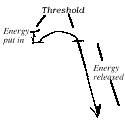TRADITIONAL FACT FINDING
Traditionally, Native people have been intuitive scientists. In their exploration of the world, they have been aware of the subtle forces acting on men, animals, and the earth.
Much knowledge has been acquired by a combination of thinking, observing, and listening. Many of the elders are leaving us now, so it is important that we not only gather from them the knowledge they have, but also learn the process by which they learned.
Their process seems gentler, less intrusive than that of western science. The basic assumptions are different. Man is seen as part of a whole rather than a dominant force. Their science has a firm connection to values.
This isn't to minimize the wonderful influences of Western science, but acknowledges that there are other ways of knowing that have validity.
PHYSICAL LAWS AND PRINCIPLES
There are certain physical laws and principles that work all the time. They represent facts that you can count on. They apply in many different situations.
They are not laws like, "If you drive a four wheeler on the roads without a license and get caught, you will get in trouble." That kind of law says, "If you get caught, something bad will happen."
Physical laws and principles are different. They happen every time, all the time. They are general rules of nature that have come from lots of observation of the natural world. Both Native people and Western scientists have spent countless hours observing how things work.
If you believe in gravity, it works. If you don't believe in gravity, it still works. By the time you went to school, you had that figured out.
When I was about five years old, I really wanted to fly. I thought "If I believe enough, I can fly." After days of thinking about this, I climbed up on the swing set my dad made for me. (I think I had a towel around my neck to flap in the wind.) I very carefully put all fear and doubt out of my mind. I knew that was important. I thought about flying with all my might, and jumped off. That was one of my first science experiments. I discovered (That's what scientists dothey discover) that believing doesn't change the law of gravity at all. My great faith in flying didn't slow my fall in the slightest. I remained on the ground for a long time. My body hurt, but my understanding was damaged even more. It took me a long time to sort it all out.
We cannot say that gravity is bad. It causes planes to crash, but it also keeps the blankets on us during the night so we won't be cold. Gravity causes rain to fall on us when we want sunshine, but you couldn't play volleyball without it.
We learn to use the positive effects of gravity, and avoid the negative effects. Gravity is a law here on earth and everywhere else in the universe.
I like physical science laws because they treat everyone fairly. Russians and Americans, Natives and Orientals, the rich and the poor are all treated without favoritism by science laws. The only people who are hurt by them are people who ignore them. If you believe in them, they work. If you don't believe in them, they still work. Great athletes aren't exceptions to the physical science laws. In a way they are scientists, because they experiment and learn how to work with them. One of the purposes of this book is to help you become aware so science laws can work for you instead of against you.
There are many science laws and principles, but there are a few basic ones that we deal with every day.
Have you ever heard of someone who ran an outboard motor, snowmachine, or chainsaw without oil in the gas? What happened? If you believe in friction, it works. If you don't believe in it, it still works.
An old man from an upriver village was traveling by boat during a heavy rain. He thought he could make it home before he ran out of gas, but his engine quit. He quickly poured gas into the tank. He forgot to put oil in the gas. Before he arrived home, his engine was totally ruined. Friction between the moving parts caused great damage, and cost him over $2,000.
Is friction bad? Not necessarily. You could not light a match without the heat from friction. We could not live without it.
You can:
- Learn about physical science laws and principles and use them, or
- Choose not to learn about them, and find out how powerful and effective they are against you.
Those are the choices before you.
QUESTIONS:
1) What are some things to do when you first search out a matter?
2) What are some of the differences between the traditional Native ways of science and the modern ways of science?
3) Name one difference between science laws and the laws of our country.
NEWTON'S THREE LAWS
Long ago, a man by the name of Isaac Newton described three physical laws. His description has helped scientists and students for centuries.
The first law is the law of inertia, which we will discuss in this book.
The second law says that the force on an object is equal to it's mass times the rate of acceleration.
What that means is this: If an object has greater mass, it takes more force to move it. It also says that the faster you try to accelerate the object, the more force it will take. Fast acceleration, more force. Slow acceleration, less force. A loaded fourwheeler takes more force to move than one with no load. It takes more force to accelerate a fourwheeler quickly than it does to accelerate slowly.
The third law says that for every action there is an equal and opposite reaction. You shoot a shotgun. The lead goes out of the barrel, but there is an opposite force against your shoulder. We say "the shotgun kicks."
Many forces operate at the same time. As we look at the reasons behind our science questions, we must realize that seldom is only one force working. There are often several. Some work together, and others oppose..
A boat floats in the river. There are many forces working on it. Gravity is pulling it towards the center of the earth. The buoyant force of the water is lifting it up. The prop is pushing it forward. The water in front of the boat is holding it back. Wind is blowing it in another direction.

INERTIA
The law of inertia says:
- Something at rest tends to stay at rest until a force acts on it.
- Something in motion tends to stay in motion until a force acts on it.
A snowball stays on the porch railing all day long until someone picks it up and throws it. That same snowball will stay in motion until it is acted upon by a target of some sort, like a sign or a tree. SPLAT. Then it will stop immediately because the tree exerted a force on it.
The bucket stops and the
contents keep going by
the law of inertia
Before we had indoor plumbing, we had to empty the slop bucket. I used the law of inertia to empty it. I set the bucket and contents in motion. I quickly pulled the bucket back, and the contents, by the law of inertia, kept going.
I once played basketball in a gym that had a stairwell behind and beneath the backboard. The school had to station a large policeman to catch players who were carried by the law of inertia into the stairwell after each layup.
The law of inertia acts on us all the time.
You travel on a snowmachine and hit a tree. You to stay in motion even though the machine has stopped. (Ouch!)
You are in an airplane when it's rough. The plane hits a bump and goes up, then hits a downdraft and drops. Inertia has your stomach going up when you are going down. It feels very unpleasant when your body and your stomach aren't traveling in the same direction. What do you feel in an elevator?
I had a dog team for years. I would often think about ways to go faster, or farther. I thought of the things that the dogs are working against:
- Friction. Smooth plastic runners help tremendously.
- Hills. I would often get off the sled and help push the sled up hills against the force of gravity.
- Bumps.
Bumps and rough terrain slow the sled below the normal pace of the dogs. The dogs have to exert more force to get the sled back to the right speed. Keeping the sled at a constant speed, so the dogs are not continually working to overcome inertia is a challenge for the musher.
The musher must push or lean to make the sled go smoothly.
Many mushers put shock cord (elastic) on the bridle of the sled to cut down on the sharp forces against the dogs when the sled slows abruptly.
How do snowmachines lessen the effect of a rough trail?
What is happening when you get catsup out of the bottle like this?
Did you ever have something stuck to your hand or finger and shake it to free yourself? Is this using the law of inertia?
Put glue on a piece of tissue. Stick it to your finger. What is your natural reaction to get it off? What principle are you using?
Explain why dogs shake after coming out of the water. What is happening?
My dad told me why pistons in engines are made of aluminum. Pistons go up and down thousands of times a minute. If the pistons were made of a heavier metal like steel, changing direction would use more energy. It would reduce the engine's power and put a great strain on the crankshaft. Light pistons have much less inertia than heavy ones traveling at the same speed.
|
|
|
|
|
Would you rather split large blocks of wood with a boy's axe or an eight pound maul? Explain this in terms of inertia.
Would you rather split kindling with a boy's axe or an eight pound maul. Explain this in terms of inertia.
Why do we use a big chopping block?
Would you use heavier or lighter bullets when hunting in the brush? Why?
Martha was going to build a dog house. In the shop she found many different hammers. She found a 16oz. and a 20 oz. hammer. Which one should she choose to drive big nails into 2 x 4's?
Which one should she use to nail a picture frame?
Harry wants to hunt geese but he is afraid of the twelve
gauge shotgun will kick too much. What advise could you give
him before he buys one? Do you think a heavier gun might
help?
What happens when you are riding a bike, and apply the front brakes without touching the rear brakes? Why does this happen?
What do you think would happen if a car's rear brakes failed and the front brakes were the only ones working? Draw this.

The head kept coming off Helen's axe. She didn't know
what to do. She tried to pound the head back on with a
hammer, but it didn't work. Can you suggest a better
way?
Frank wants to build a displacement boat with a rounded front to have more room inside the boat. He is going to haul big loads. His dad tells him to make the front more pointed with gradual turns to cut the water gradually. Which do you think is right?
TOOLS/EQUIPMENT WE USE TO INFLUENCE INERTIA
When something is at rest, we push, pull, or use engines and motors as outside forces to get it in motion.
When something is in motion, we use brakes to slow it down or stop.
Describe how the brakes work on:
- a four wheeler.
- a car or truck
- an airplane landing
- a dog sled on clear ice and powder snow.
Friction is used to influence the inertia of something moving.
What kind of "brakes" do you use to control your motion in sports? Compare three different brands.
INERTIA ON CURVES AND CORNERS
Have you ever, on a rainy day, ridden a bicycle that had no back fender? What happened?
When you go slow, it's okay, but when you go fast, the water flies off the rear tire and paints a muddy stripe down your back.
Why does this happen? The law of inertia says, "A body in motion tends to stay in motion until acted upon by some other force." We can add a little to that and say, "A body in motion tends to stay in motion in a straight line until acted upon by some other force."
The water and mud on your tire, by the law of inertia, stay in motion in a straight line until acted upon by another force (your back).
The first three wheel ATV our family owned was a little Honda 110. It was fun for the whole family to drive. It was not fun for the whole family to maintain. No one wanted to tighten the chain when it got loose. They drove it with a loose chain.
One day, one of our children walked into the house and said, "The three wheeler stopped." That really meant, "Dad, you have a problem." I went out to get it going. It had gas. The switch was on. It started, but made funny noises. I stopped it, and checked the oil. It was empty! I remembered checking the oil two days earlier. How could it be empty? I pushed it home.
The next day, I discovered the problem. The loose chain, by inertia, had flown forward from the front sprocket, and had gouged a hole in the crankcase. The oil ran on the ground as fast as we poured it in.
That was an expensive lesson in inertia. Remember, science laws work whether you believe in them or understand them or not.
Water, as it flows around the bends of a river, follows the law of inertia, tending to go straight rather than change direction.
If there is a bend in the river, where is the current the fastest?
Where is the river the deepest?
Many towns in the North are threatened as the rivers, influenced by inertia, take land and houses by erosion. What slows erosion?
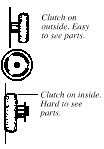
Get a chainsaw. Remove the sprocket ![]() cover,
the bar and chain. Safely start the saw and watch the clutch
work. What laws are working to cause it to expand and force
the drum to turn?
cover,
the bar and chain. Safely start the saw and watch the clutch
work. What laws are working to cause it to expand and force
the drum to turn?
What would happen if the spring holding the shoes became weak? What would happen if you replaced it with one too strong?
Erin notices that the bar oil on his chainsaw sprays off the bottom of the roller nose on his bar in cold weather, and off the top in warm weather. Why is this? Should he be concerned?
Cold weather
When a boat prop is damaged by hitting the bottom, it causes the motor to shake. Why is this happening? What damage do you think it can do?
Have you seen or used an "Eskimo yo-yo"? What keeps the two balls extended at the end of the string?
Brian was riding the sled behind the snowmachine. His brother Einer was driving. They were cold, so Einer drove fast. As they came into the village, they went around a corner. The snowmachine turned ok, but the sled swept sideways, almost beside the snowmachine. The sled hit a chunk of ice, and flipped over. Explain what happened using the concept of inertia.
QUESTIONS
1) What are Newton's three laws? State them. Give an example of each.
2) Give an example of a situation where more than one force is working at a time.
3) Give three examples of the law of inertia working. One should be from your own experience and not from this book.
4) Why does a dog shake when coming out of the water? How does he use the law of inertia?
5) Describe one method of putting an axe head back on.
6) Draw one tool we use to overcome inertia.
7) Why does water splatter your back when you ride a bike in the rain (if you have no rear fender.)
8) Describe or draw how a chainsaw clutch works.
9) Give two examples of inertia working for or against you in your own life.
FRICTION
Friction is the resistance to motion when surfaces are in contact.
Static friction is when the surfaces are not moving, and kinetic friction is when they are moving in contact with each other. Static friction is usually much greater than moving friction. It is hard to get a sled moving, but once it slides it pulls easily.
Rub your hands together. Do the same thing with soap on your hands. Which would has more resistance? Soap lessens friction. Almost every movement on earth has friction.
Sometimes we try to increase friction.
Years ago we occasionally crossed icy windswept mountains. We would often put socks or burlap sacks over our shoes to avoid slipping on the windblown ice and snow. We tried to increase friction to keep from sliding off the mountain.
We used to put wood stove ashes on the steps and walkways of the elders homes so they wouldn't slip on the ice and snow. Stove ashes greatly increase friction.
Sometimes we try to decrease friction.
Before plastic runners on dog sleds, we spent much time changing from steel runners in warm weather to wooden runners in cold weather. We were trying to decrease the dogs' work against friction.
When the weather was below freezing, most mushers iced wooden runners in the morning with a wet rag. The iced runners had low friction. However, if the weather warmed, the ice melted and the sled was almost immovable on the roough wooden runners.
Steel runners were very slippery when temperatures were above freezing, but they frosted, and were like sandpaper when the thermometer fell below 25°.
Some materials increase friction. Rubber, rock and wood all have high friction surfaces.
Some materials decrease friction. Oil, grease, plastic and ice all have low friction surfaces.
In general,
the rougher a surface, the more friction it has.
the smoother a surface, the less friction it has.
INCREASING FRICTION
Some objects are made to increase friction. Tires, tennis shoes, brakes of all kinds (car, sled, and airplane), as well as gloves, snowshoes, and tool handles are all designed to increase friction to improve use.
Get some of the above, look closely, and handle them. What do you conclude?
We made a moose skin boat in the spring of the year. It was very hard to tie the wet moose skin when we lashed it together. The skin was too slippery. One of the old timers put a small bunch of grass on the end of the strip of moose skin and tied the knot around it. The grass increased friction and the knot held.
Another time we were hanging fish on poles to dry. The poles weren't spruce, and the fish kept slipping. A little grass placed on top of the pole before the fish was hung increased friction and kept it from falling.

DECREASING FRICTION
Some objects are made to decrease friction. Wheel barrows, sled runners, wax coated bullets, underwear made of synthetic materials, and nylon starter cords are all made to decrease friction.
A boat bottom should be painted and smooth or the owner will use lots of gasoline overcoming friction with the water.
Some boat paints have compounds in them to keep water plants from attaching to the boat. When we lived on the Stony River, the current was very swift. We had no problem with this. When we lived on the Holitna River, the current was so slow we had lots of aquatic plants growing on the boat. We had to use treated paint to avoid plant growth that produces friction.
You may have noticed that a boat will travel faster in choppy waves (1"to 5"). Air is trapped under the boat. Friction with air is far less than with water.
Without oil and grease to reduce friction, no machinery could work for long. Iron against iron creates much resistance, heat and wear. Oil an old pair of scissors. Can you tell the difference before and after oiling?
There are many kinds of oil. Some lubricate, some do not:
- crankcase oil for a car,
- two cycle oil for a snowmachine,
- bar oil for the chainsaw bar,
- diesel engine oil for an electric generator,
- thin lubricating oils for cold weather,
- thick lubricating oils for warmer weather, and even
- cooking oil to cook your hotcakes and
- seal oil and bear fat for lamps (not lubricants)
Without oil, our civilization could not have developed. Most oils reduce friction of moving parts.
A child came crying to her mother with a finger stuck in the mouth of a bottle. The mother poured liquid soap around the finger, and the child's finger slid out of the bottle with no harm or pain.
An understanding of friction is very important to an intelligent world view. Both engineers and mothers need to understand it.
How does friction effect the following:
- Airplanes?
- Swimmers?
- Bicycle bearings?
Arnold lived in Fairbanks Alaska. He couldn't understand why the front wheel bearings wore out quickly on his car. The previous owner was from Alabama. Can you explain this to him?
An unlubricated fishwheel creaks, groans and scares away fish. When we don't have grease for the bearing, we lubricate with salmon eggs that have considerable amounts of oil. Can you think of other lubricants?
Name ten things that move.
Identify the points where two surfaces are moving against each other. Don't forget friction with air.
What is being done to increase or decrease friction at that point?
Get a moose or caribou leg. Take it apart at the knee. Observe the fluid in the joint. Feel the fluid between your fingers. Will it reduce friction? Observe how smooth the cartilage is.
You are on a mountainside. You are afraid to go down the mountain with your dog team. Your brake isn't good enough. What could you do?
George doesn't have enough money to paint his boat. He thinks of putting it in the water without paint this year. What advise can you give him?
Try a pair of waxless cross country skis. Explain how they have more friction when traveling in one direction than when traveling in the other.
How is this same effect created on skis that use wax?
Draw this in action: A ski gliding, and a ski kicking. label and explain.
Some snowmachines have slide rail suspension and older ones have bogie wheels. Why is there a difference? Which is better for what conditions?
Why did old timers use spruce poles to hang fish, and not birch or willow?
QUESTIONS
1) What is friction?
2) Name five situations where you might want to reduce friction.
3) Name five situations where you might want to increase friction.
4) What is viscosity?
5) Give five examples of how old timers showed their understanding of friction.
SURFACE AREA
Surface area is the amount of surface that is exposed. You can hold a piece of paper in the air. It has a large surface area exposed to view. You can lay the paper on a desk. The back is now touching the desk. It has less surface area exposed to view. You can ball the paper up in a little ball, and it has even less surface area exposed.
Understanding surface area helps us explain many useful science phenomina in village life. When you dry fish, you try to increase the surface area which can dry. When you sharpen a knife you try to reduce the surface area so the blade will penetrate the meat or fish.

If you jumped out of an airplane without a parachute, you would fall fast and be dead on impact. With a parachute you are increasing the surface area in contact with the air. With a parachute, you bump into many more air molecules, slowing you to the point at which you can land safely.

Why do chainsaws and most snowmachine engines have fins on the cylinders?
Why do dogs curl up at night in the winter?
If you want a snowmachine for breaking trail in soft snow, would you get one with a large or small track?
Why?
If you want a snowmachine for racing, would you get one with a small or large track? Cleated or uncleated?
Penny has to cook supper in a hurry. The family expects to have fried moose meat. How can she cut the meat so it cooks faster?
![]()

Why did old timers make shavings to start a fire in the morning?
I used to fly from the Yukon river to the Kuskokwim during the winter. I noticed that both rivers could have clear weather, but it would be foggy in the Beaver Mts. between them. Why do you think this happens?
Years ago when we traveled only by dog team, we sometimes had to cross thin ice. We spread our dogs out on a long towline. This did two things: it increased the surface area that our dog team occupied on the bad ice. Pounds per square foot were much less that way. We were less likely to fall through the ice. Second benefit: When we did fall through, there were usually several dogs far ahead of us on solid ice who could pull the rest of us out.

However, a team spread out like that couldn't travel through timber without bumping trees and getting badly tangled. We had to shorten our towline after crossing bad ice.
QUESTIONS
1) What is surface area?
2) Give two examples of reducing surface area.
3) Give two example of increasing surface area.
4) Why do you think mittens are warmer than gloves?
5) Why do you think we use snowshoes for walking on the snow?
6) Why do you think we sharpen a knife to a very thin edge?
CONDENSATION
Facts:
1) Water exists in three forms: solid, liquid, and gas.
- As a solid it is ice.
- As a liquid it is the water we pour and drink.
- As a gas or vapor it mixes with the air and will not remain in a container. (It is important to distinguish between a gas, which is an element or compound that cannot be held in an open container, such as air, and "gas," meaning gasoline. While the words are the same, the meanings are very different and cause for confusion.)
2) Warm air holds more moisture (water) than cold air.
3) Evaporation and condensation are opposites.
- Evaporation is when a liquid such as water becomes a gas.
- Condensation is when a gas becomes a liquid such as water.
When we go outside in the winter we see our breath. We can't see it in the summer. Why?
Single-pane windows frost when it is cold outside. What is happening? Where does the water come from? What do we do to prevent this?
People who wear glasses see clearly outdoors when it is
cold. As soon as they come inside, the glasses fog up. Why?
What do people do to get the fog off the glasses.
How does this help? Some people say they won't fog if you walk into the house backwards. Does this work?
Do the above. If it is warm outside, put the glasses in a freezer.
When people want to get dirt from their glasses while inside the house, how do they clean them?
Why did old timers keep their guns outside during the winter?
During fall time on the river or in the valleys, there is often fog in the morning. Why? Where does the fog (water) come from?

Many northern homes burn to the ground because uninsulated stovepipes become rusted and thin at the point where the pipe emerges from the building. Why is this? What could you do to prevent this?
During very cold weather,
fog appears in the doorway when the door is opened. Where
does the fog come from?
Moxie was really cold in his sleeping bag. He tucked his head inside the bag. It warmed up a lot from the heat of his breath. At 4 a.m. he was colder than before. The outside temperature had not gone down since he went to bed. Why do you think this happened?
Why do you think the windshield on a truck, car, or snowmachine frosts more heavily overnight than the rest of the vehicle?

Look at the lid of a dutch oven. The steam condenses on the cooler lid, and the water drips back onto the food, causing the meal to be moist, and the juices of the different foods to mix. Without the drippers, the steam would condense on the top and run down the sides. The middle of the pot would be relatively dry.
My son-in-law noticed that he always had trouble with his snowmachine after a warm spell. The engine would shoot and backfire for one or two days, and then it was okay again. He couldn't understand why.
Finally, he heard some airplane pilots talking. They said they always keep their gas tanks full during warm weather. If a tank is half full of gas, it is half full of air.

When the weather turns cold, the warm air inside the tank cools. The water that was in the warm air condenses in the tank forming frost. This is very dangerous in an airplane.
My son-in-law remembered this. During the next warm spell, he kept his snowmachine tanks full. He had no water or ice problems when the weather turned cold. The frost had caused the "shooting" as the ice exploded into steam in the cylinder.
![]()
I was in the Hawaiian Islands. I noticed that most of the islands had a dry side and a wet side. The warm damp air comes off the ocean. As it rises up the mountainside, it cools. The water condenses (rain). When the air goes down the back side, it warms up again, drawing moisture from the plants and soil. One island, Lanai, does not have a dry or a wet side. It is a low island, with no mountains or peaks.
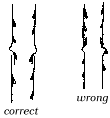
Why does Fairbanks have drier summers than Anchorage? Look at a contour map.
I worked underground in Red Devil mine. I had an excellent raincoat, yet I was very wet at the end of every day. Why do you think this was so?
Why do stovepipes connect like the pipe on the left rather than the one on the right?
QUESTIONS
1) What is condensation?
2) Give five examples of how condensation has affected life in Alaska.
VAPOR BARRIER
We use a thin plastic vapor barrier in all Alaskan houses. If the vapor barrier is between the insulation and the home, warm damp air inside the home is never cooled off, and cannot condense.
If the vapor barrier has a hole in it, warm air escapes through the hole, and somewhere in the wall or ceiling, it is cooled enough to condense. It then wets the insulation, making it inefficient. It also causes rotting inside the wall.
An old timer lived in a log cabin with a sod roof. When rolls of plastic first came to the Alaska, he fixed his roof.
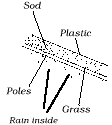
In the summer he:
- removed the old sod
- put more grass on top of the roof,
- covered the dirt with moss and sod.
- covered this with more dirt, and
- covered the sod with heavy plastic.
Winter came, and he was glad that his house was much warmer than before. One day the weather warmed. It started raining inside his house when it was sunny outside. It dripped everywhere. He wondered why. Can you explain this?
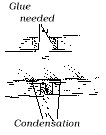
In one of the schools in our district the gym roof leaked every time the weather warmed. Maintenance workers went all over the roof looking for holes in the steel. They found no possible leaks. Months later they discovered the problem. The roof was made of pre-fabricated panels. They were put together like the illustration on the left.
When the contractors built the building, they did not put enough glue between the panels when they nailed them together. Warm air escaped between the panels, and frosted on the back side of the roofing steel. What they thought was snow and rain leaking through the roof was actually the condensation of people's breath dripping back on them. The moisture had never left the building.
Bernie went from his village and stayed in a fancy hotel.
He was amazed that there was something like a towel or
blanket around the toilet bowl and toilet tank. He
couldn't understand this at all. Can you explain it to
him?
Evaporation
Evaporation is when a liquid becomes a gas (vapor).
Evaporation is the opposite of condensation.
There are times when we want evaporation to take place.
- We hang fish in the smokehouse.
- We hang meat to make dry meat.
- We hang clothes on the line.
When the white gas in a camp stove passes through the
small pipe that goes from the tank to the burner it is
heated by the flame  of
the burner. This causes the white gas to evaporate in the
pipe. When the white gas comes out of the burner it burns
much more thoroughly as a vapor than as a liquid.
of
the burner. This causes the white gas to evaporate in the
pipe. When the white gas comes out of the burner it burns
much more thoroughly as a vapor than as a liquid.
What do you think will happen if the generator is dirty where evaporation is supposed to occur?
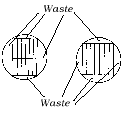
 carburetor
throat, causing dangerous engine conditions for landing. It
is surprising, but the time this is most possible is around
40o to 50oF, as there is more moisture
in the air at that warmer temperature.
carburetor
throat, causing dangerous engine conditions for landing. It
is surprising, but the time this is most possible is around
40o to 50oF, as there is more moisture
in the air at that warmer temperature.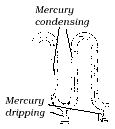
 ght
in a little village close to Mt. Denali. Many days I could
look out and see a little cloud behind the peak of the
mountain.
ght
in a little village close to Mt. Denali. Many days I could
look out and see a little cloud behind the peak of the
mountain.

